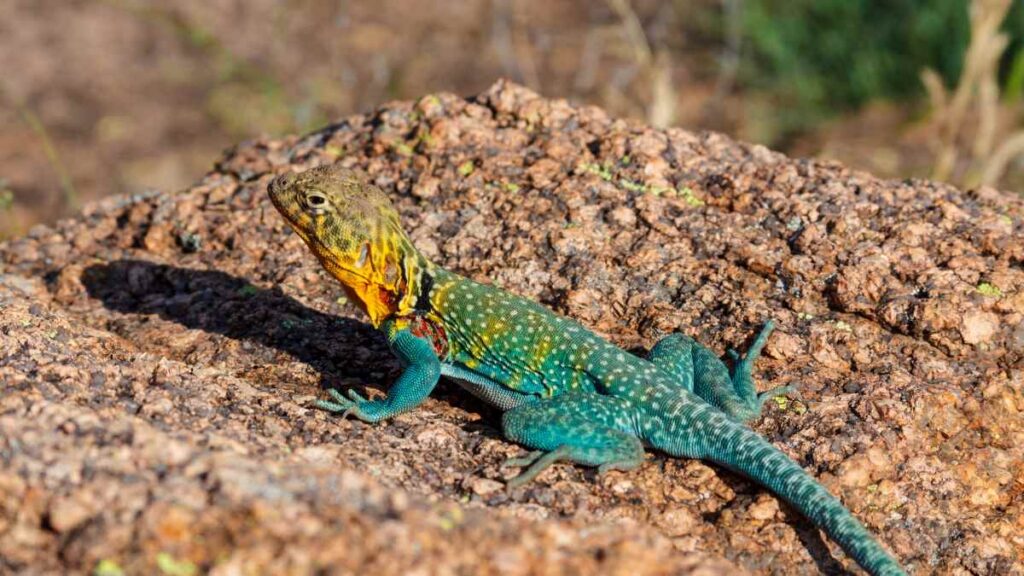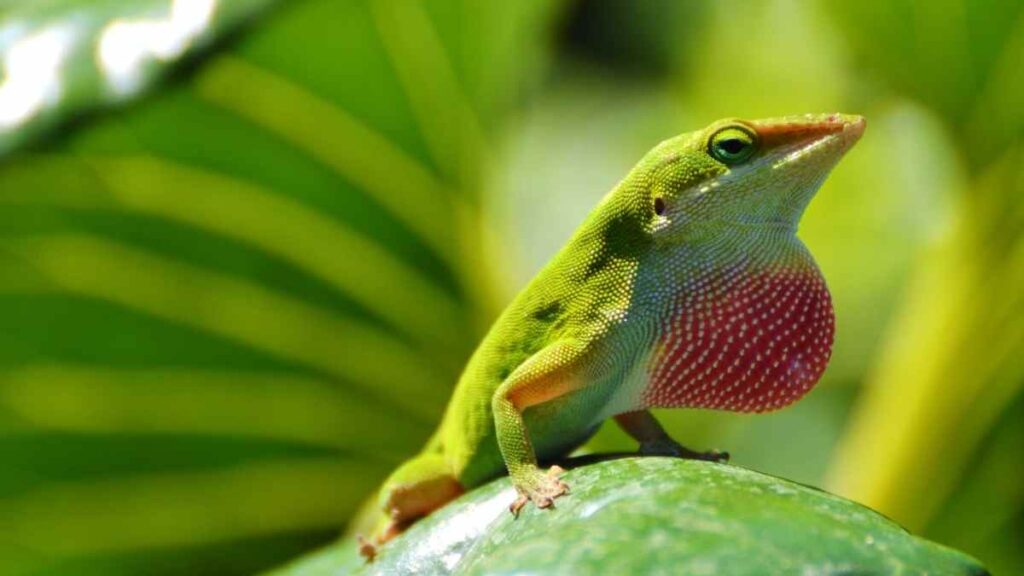Are you ready to discover the secret world of lizards that change colors?
Sure, it is one of the most common lizard facts, but you may not know how and why they change colors.
These incredible creatures can shift their hues and patterns, adapting to their environment in the blink of an eye!
Imagine a lizard blending seamlessly into its surroundings, evading predators with its camouflage abilities. Or a lizard signaling its territorial status or attracting a mate with a bold display of colors.
This article will explore the biology of color change in lizards, the ecological significance of the color change, and examples of lizards that change color. We will also delve into the fascinating world of these color-shifting creatures and discover how they use color to survive and thrive in the wild.
Lizards Changing Colors – An Overview

From the masters of disguise to the fashionistas of the reptile world, these lizards are some of the most fascinating creatures on the planet.
Think about it; a lizard can change its hue and pattern to match its surroundings in the blink of an eye, making it almost invisible to predators. It’s like the ultimate game of hide-and-seek, where the lizard always wins.
But it’s not just about survival; lizards also use their color-changing abilities to signal their territorial status, attract a mate, and even communicate with their species.
-

Beaded Dragon Fan Exclusive: ‘Original Hipster’ T-Shirt – Wear Your Unique Style with Pride – Unisex t-shirt
£13.00 – £20.50 Select options This product has multiple variants. The options may be chosen on the product page -

Chinese Water Dragon Aquatic Mastery Tee: Dive into Elegance with Our Exclusive Reptile Enthusiast Shirt – Unisex t-shirt
£13.00 – £20.50 Select options This product has multiple variants. The options may be chosen on the product page
The Biology of Color Change in Lizards

The biology of color change in lizards is a complicated and intriguing subject. Let’s explore the science behind these color-shifting superstars.
It’s important to understand that lizards don’t actually produce color. Instead, they have specialized cells called chromatophores, filled with pigments, and these pigments give lizards their different colors.
The most typical pigments found in lizards are melanin and carotenoids. Melanin is a pigment responsible for the dark, black, and brown hues seen in many lizards, and carotenoids are responsible for the red, orange, and yellow hues.
But it’s not just pigments that give lizards their ability to change color. Lizards also have cells called iridophores and leucophores. Iridophores reflect light, giving lizards a metallic sheen, and leucophores are cells that scatter light, giving lizards a pale, ghostly appearance.
Now, how do these pigments and cells change color?
It’s all thanks to an intricate system of muscles, nerves, and hormones that control the size and shape of the chromatophores.
When the lizards need to change color, their brain sends signals to the chromatophores, telling them to expand or contract. As the chromatophores change size, the pigments inside them become more or less visible, resulting in a change of color.
But that’s not all.
Some lizards also have specialized cells called reflectors, which can change how light is reflected off their skin. These reflectors can manipulate the colors we see by reflecting different wavelengths of light.
Lizards are not only cold-blooded creatures but also color-shifting chameleons, thanks to a complex interplay of pigments, cells, and hormones that they use to control and change the colors in their skin.
Next time you see a lizard changing colors, you’ll know that it’s not magic, it’s science in action.
How Lizards Change Colors

Now, let’s talk about control.
How do lizards control and regulate their color changes? The answer is a complex interplay of nerves, hormones, and muscles. as we mentioned above, when a lizard needs to change color, its brain sends signals to the chromatophores, telling them to expand or contract. As the chromatophores change size, the pigments inside them become more or less visible, resulting in a change of color.
Think of it like a game of musical chairs, but instead of chairs, it’s chromatophores, and instead of music, it’s hormones. As the chromatophores expand or contract, the pigments inside them shift and change, creating a dazzling display of color.
Ecological Significance of Color Change

First and foremost, lizards use their color-changing abilities as camouflage to blend in with their surroundings and evade predators. When a predator is approaching, lizards will quickly change color to match the background, making it almost impossible for the predator to spot them.
It’s like a game of hide-and-seek, but instead of hiding behind a couch, lizards can blend into their surroundings, making them the ultimate winners.
But color change isn’t just about hiding from predators. It’s also an important tool for lizards regarding social interactions and communication.
Lizards use their color-changing abilities to signal to other lizards their territorial status or as a way to attract a mate.
For example, Anoles use their brightly-colored dewlap to assert dominance or attract females. It’s like a peacock’s tail but with a lizard version.
But it’s not just males that use color change for communication and attraction. Females also change color to signal their reproductive status, and they’ll even use their color-changing abilities to fake being pregnant to deter other males from bothering them. It’s like wearing a “Do not disturb” sign, but instead of a sign, it’s a color change.
Lastly, it’s worth mentioning that color change is also crucial for lizards to communicate with their species. By changing color in specific ways, lizards can communicate things like “I’m ready to fight,” “I’m ready to mate,” or even “I’m not feeling well.” It’s like a secret lizard language, and only other lizards can understand it.
In short, the ability of lizards to change color is not just for amusement or aesthetic reasons, but it’s an essential mechanism for survival, adaptation, and communication.
From blending in with their surroundings to signaling their status and intentions, lizards have grasped the art of color change and use it in multiple ways to navigate and survive in the wild.
Lizards That Change Colors – 4 Examples
Chameleons

First, we have the chameleons, probably the most widely known lizards that can change color.
These lizards are the true masters of disguise, able to blend in with their surroundings in the blink of an eye. With the ability to change color to match the environment, these lizards are the ultimate camouflage experts.
Chameleons are also known for their grasping hands and feet, which they use to climb and grip branches, making them one of the most unique lizards in the world.
Skinks

Next, we have the skinks. These lizards are the fashionistas of the reptile world, known for their bold color changes and patterns.
Some skinks can change color from green to brown, while others can switch between bright blue and orange. They are also known for their small size and smooth scales.
Geckos

Another group of lizards that change color is the geckos.
While they are not as flashy as skinks, geckos can change color to some extent, changing their hue to match their surroundings, which helps them avoid predators and capture prey.
Geckos are also known for their sticky feet and nocturnal nature.
Anoles

Last but not least, we have the anoles. These lizards can change color from green to brown, using this ability to communicate with other lizards and signal their territorial status.
Anoles are also known for their “dewlap,” a colorful flap of skin on their throat that males will flare to attract females or assert dominance.
Conclusion
We’ve reached the end of our wild ride through the vibrant and ever-changing world of lizards.
From the masters of disguise to the fashionistas of the reptile world, we’ve explored the incredible ability of lizards to change color and the many ways they use this ability to survive and thrive in the wild.
We’ve learned that lizards use their color-changing abilities as camouflage to blend in with their surroundings and evade predators, as a way to signal their territorial status or attract a mate, and even as a way to communicate with their species.
We’ve also seen the different types of lizards that change color and the incredible color patterns and changes they exhibit. From chameleons and skinks to geckos and anoles, each species has its unique way of adapting to its environment and communicating with the world.
Good luck!

